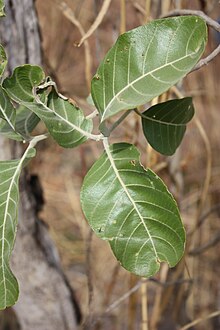Combretum glutinosum
| Combretum glutinosum | |
|---|---|
 |
|
| Leaves of Combretum glutinosum, Pama Reserve, Burkina Faso | |
| Scientific classification | |
| Kingdom: | Plantae |
| (unranked): | Angiosperms |
| (unranked): | Eudicots |
| (unranked): | Rosids |
| Order: | Myrtales |
| Family: | Combretaceae |
| Genus: | Combretum |
| Species: | C. glutinosum |
| Binomial name | |
|
Combretum glutinosum Perr. ex DC. |
|
Combretum glutinosum is a shrub species of the genus Combretum, found in the Sahel belt in parts of Senegal, Burkina Faso, Ghana, Mali, the Gambia, Niger, Nigeria and Cameroon, across to parts of Sudan. It is known as dooki in Pulaar, Kantakara in Hausa, rat in Wolof and jambakatan kè in Maninka. Its synonyms are Combretum cordofanum Engl. & Diels, C. passargei Engl. & Diels, C. leonense Engl. & Diels.
Combretum glutinosum tends to grow in savanna type forests, in several soil types but is best suited to sandy and free draining soils. It is drought resistant and grows in areas of annual rainfall of 200–700 millimetres (7.9–27.6 in). Its growth is fast and profuse.
As a bushy shrub the plant grows up to 12 metres (39 ft) with an open crown with low branches that droop down, and is deciduous. The trunk is usually twisted and low branched, with grey-black rough bark. The thick leathery green leaves have a gummy feel to them and are glutinous when young. The plant flowers during the dry season after the bush fires which facilitate leaf flushing that supports flowering.
In Burkina Faso and Mali, flowers tend to appear between December and March, but this varies from area to area and flowers may appear as late as July. The fruit is a four-winged elliptic samara, and has a sticky feel, reddish and turns yellowish towards the end of the season. The fruit typically measures 2.5–4 centimetres (0.98–1.57 in) long and 1.5–3 centimetres (0.59–1.18 in) across. It bears fruits generally in January and fruiting lasts until November. Seeds are collected by shaking the branches of the tree. The seeds are oil bearing and one kilogram contains about 20,000 seeds, and it has an oil potential yield of c. 24%. The plant parasite which infects Combretum glutinosum is Loranthaceae.
...
Wikipedia
